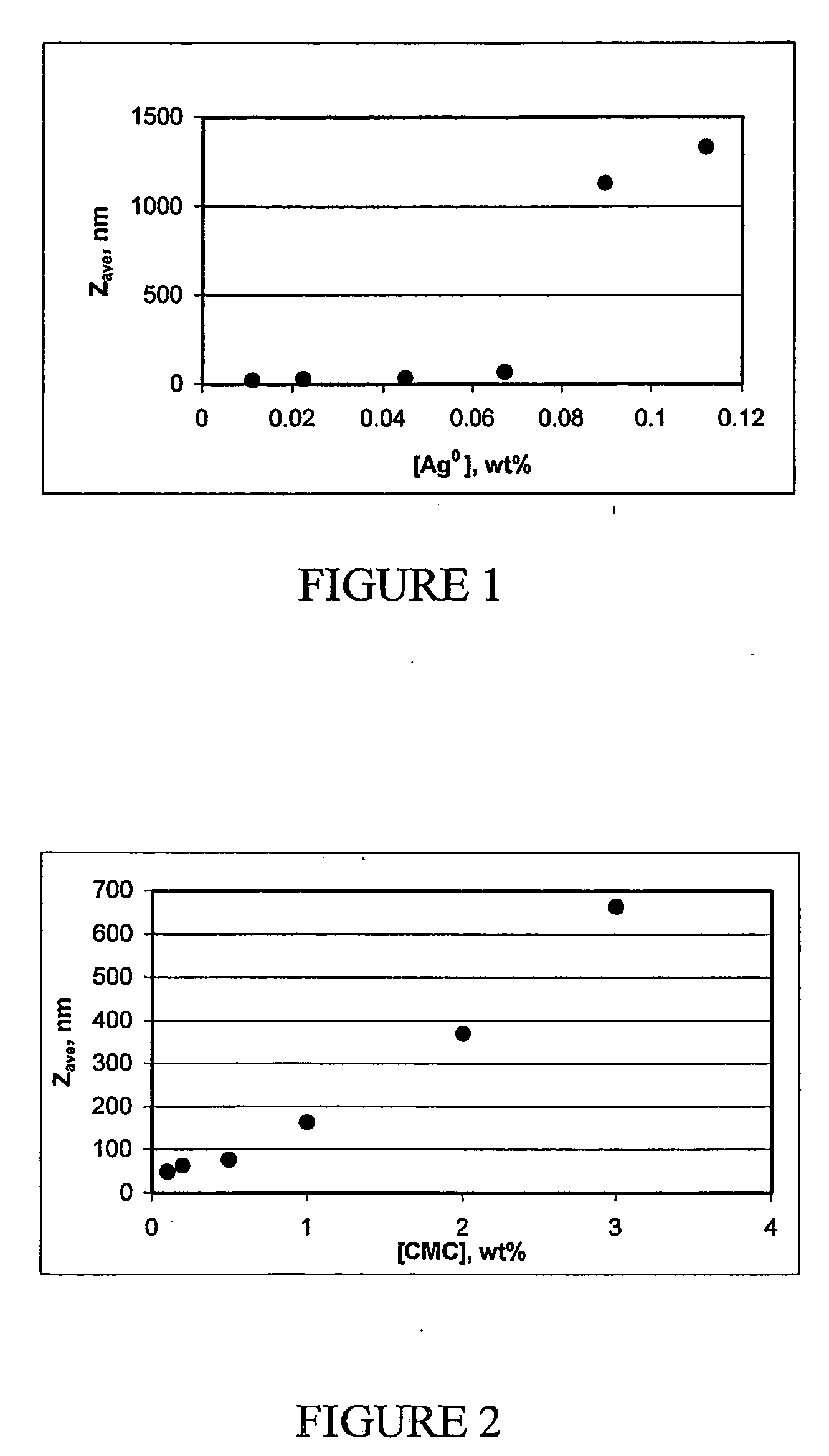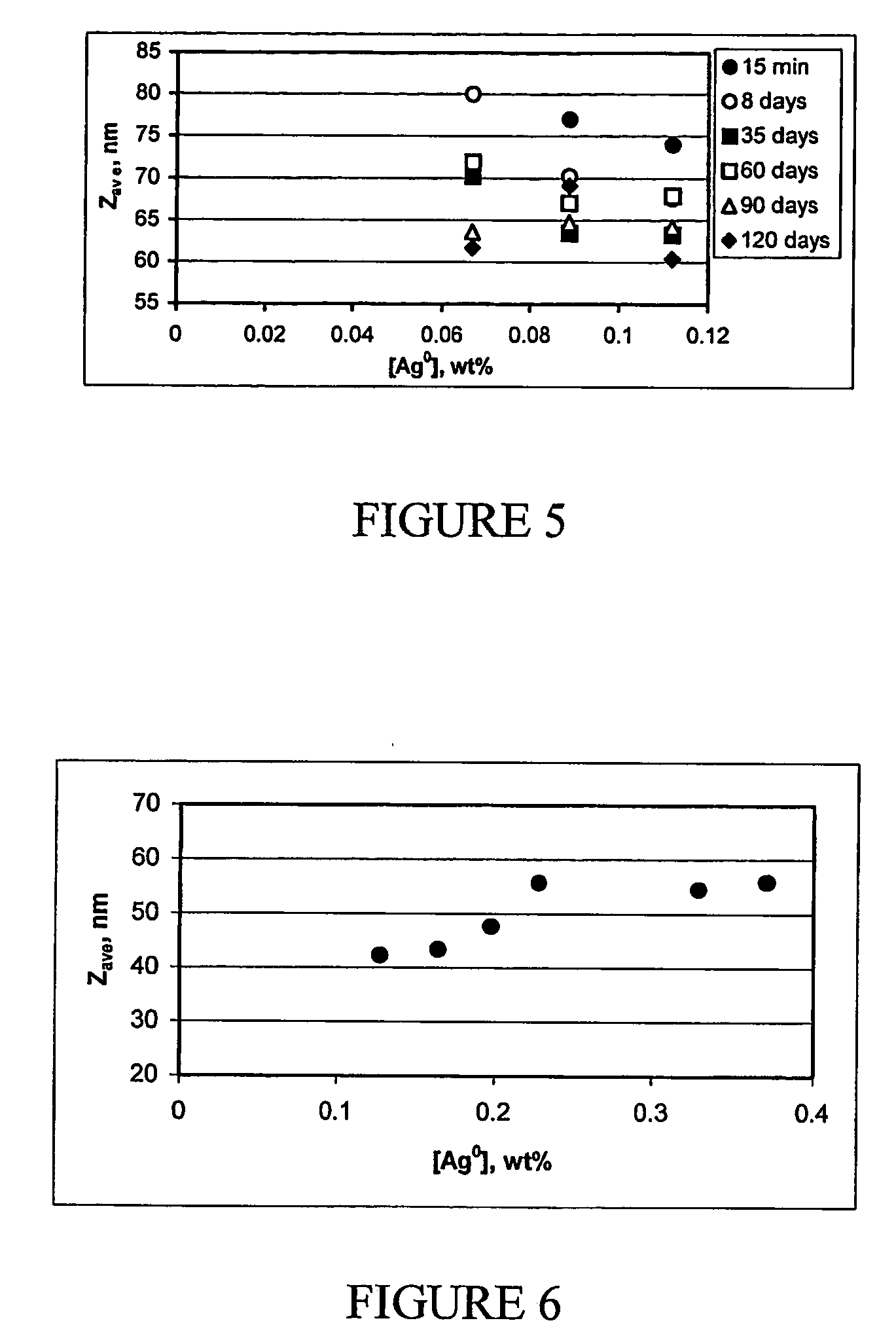Ink-jet inks containing metal nanoparticles
a technology of metal nanoparticles and inkjet printing, which is applied in the direction of printing, non-conductive materials with dispersed conductive materials, and inks. it can solve the problems of difficult adhesion of droplets onto substrates, time-consuming and expensive techniques based on molten metal expelling, and low viscosity grade. , the effect of slow sedimentation ra
Active Publication Date: 2005-04-14
YISSUM RES DEV CO OF THE HEBREWUNIVERSITY OF JERUSALEM LTD
View PDF8 Cites 193 Cited by
- Summary
- Abstract
- Description
- Claims
- Application Information
AI Technical Summary
Benefits of technology
[0014] The present invention provides compositions and methods for the preparation of water-based ink-jet inks, in which the pigments are nanoparticles of metal, and composition and methods for preparing stable, concentrated metallic nanoparticles dispersions. The ink composition of the present invention overcomes a common problem in pigment containing ink-jet inks, namely sedimentation, since the particle size is very small, below 100 nanometers, preferably in the range 20-60 nanometers, thus the sedimentation rate is very slow, and is hindered by the Brownian motion. Another aspect of the invention is that the stable dispersions of nanoparticles are prepared in the presence of suitable polymeric stabilizers, which prevent the particles from growing during the aggregation process, even if the nanoparticles are present at a high concentration in the liquid. The stabilizer is a water-soluble polymer or a surfactant, or a combination of the two. It was found that the best stabilizer is carboxymethyl cellulose sodium salt (CMC), low or medium viscosity grade. It was found that the CMC can also function as the binder in the ink-jet ink formulations, namely, as the component which provides the adhesion of the ink droplets onto the substrate, while the substrate can be made of various materials, such as plastics, paper, glass, etc. . . . CMC also allows for the modification of the viscosity of the ink for the viscosity range required for the ink-jet printing.
[0016] In a different embodiment of the invention, in order to increase the conductivity of printed circuits without sintering at elevated temperature we also used a new approach, based on flocculation of the metallic particles, after printing. Using this approach, first the metallic dispersion is printed, followed by printing a second layer of aqeous solution of a flocculant. The flocculant causes aggregation of the metallic nanoparticles, after they have been printed, thus bringing them into close contact, and improving the possibility for obtaining electrical conductivity. We describe here the use of two flocculants, representing two classes of flocculation agents, but the process may be obtained with a large variety of flocculants. The flocculants used are either an electrolyte having high valency ions, or polymer whicj is has electrical charge opposite to that of the metallic nanoparticles, such as: aluminum sulfate, poly(diallyldimethylammonium chloride (PDAC) or a charged, water soluble conductive polymer. Addition of Al2(SO4)3 induces the compression of the electrical double layer around colloidal particles that leads to overcoming the energy barrier caused by repulsive forces. As a result, attractive Van der Waals forces pull the nanoparticles into contact following aggregation. It is generally accepted that polymeric flocculants act by adsorption and “bridging”, resulting in the formation of tough flocs of colloidal particles, such that a low-temperature “sintering”-like process takes place. Obviously, if the bridging polymer is conductive by itself, a better electrically conductive layer can be obtained.
[0017] The present invention focuses mainly on the formation and printing of silver nanoparticles by ink jet printers, but may include, as clear for those skilled in the art of nanoparticles, nanoparticles of metals other then silver, such as gold, copper, etc. . . . In addition, it is clear that the metallic patterns can be used for decoration purposes, even if the resulting pattern is not electrically conductive. Another aspect of the invention is that the resulting pattern of the silver nanoparticles has an antimicrobial effect, due to the presence of silver nanoparticles, thus eliminationg the need for antimicrobial agents which are often introduced into water based ink jet inks.
Problems solved by technology
Microfabrication of such structures by lithographic technique is a time-consuming and expensive process.
Techniques based on expelling small droplets of molten metals onto substrate have met several problems, such as difficulty of adhering droplets onto a substrate, oxidation of the liquid metal, and the difficulty of fabrication a droplet-expulsion mechanism compatible with high temperatures.
Each system has drawbacks: pigments tend to aggregate, and therefore clog the nozzles in the orifice plate, or the narrow tubings in the printhead, thus preventing the jetting of the ink while printing.
Dyes tend to dry, and form a crust on the orifice plate, thus causing failure in jetting and misdirection of jets.
The synthesis of stable colloidal systems with high metal concentration is a serious problem.
However, the preparations of stable silver colloids, described up to now in the literature, in procedures based on reduction of metal from solution, have low metal concentrations, which amount only to 10−5- 10−2 M (about 0.0005-0.1%) even in the presence of stabilizers (it is almost impossible to obtain a stable aqueous silver colloid with the metal concentrations higher then 10−3 M without an additional stabilizer, due to immediate particle aggregation).
Method used
the structure of the environmentally friendly knitted fabric provided by the present invention; figure 2 Flow chart of the yarn wrapping machine for environmentally friendly knitted fabrics and storage devices; image 3 Is the parameter map of the yarn covering machine
View moreImage
Smart Image Click on the blue labels to locate them in the text.
Smart ImageViewing Examples
Examples
Experimental program
Comparison scheme
Effect test
example 1
[0091]
Silver nanoparticles (0.18%) in 0.2% CMC solution99.75%, w / wBYK-154 0.25%, w / w
example 2
[0092]
Silver nanoparticles (0.18%) in 0.2% CMC solution94.95%, w / wBYK-348 0.1%, w / wDPnB (dipropyleneglycol butyl ether) 5%, w / w
example 3
[0093]
Silver nanoparticles (1.44%) in 0.1% CMC of solution98.9%, w / wDisperbyk-181 0.1%, w / wDisperbyk-1841.00%, w / w
the structure of the environmentally friendly knitted fabric provided by the present invention; figure 2 Flow chart of the yarn wrapping machine for environmentally friendly knitted fabrics and storage devices; image 3 Is the parameter map of the yarn covering machine
Login to View More PUM
| Property | Measurement | Unit |
|---|---|---|
| Fraction | aaaaa | aaaaa |
| Percent by mass | aaaaa | aaaaa |
| Percent by mass | aaaaa | aaaaa |
Login to View More
Abstract
Compositions for use in ink jet printing onto a substrate comprising a water based dispersion including metallic nanoparticles and appropriate stabilizers. Also disclosed are methods for the production of said compositions and methods for their use in ink jet printing onto suitable substrates.
Description
FIELD OF THE INVENTION [0001] The present invention relates to the field of ink jet inks and ink-jet printing. More specifically, the present invention describes water based ink-jet inks compositions, which contain metal nanoparticles and polymeric additives dispersed within the liquid vehicle comprising mainly water, and methods for the formation of stable, concentrated dispersions of metallic nanoparticles, and inks containing such dispersions. After printing a pattern on a substrate with the use of ink-jet printer, which is either DOD (drop on demand piezo or bubble), or continuous, a layer of the metal nanoparticles is formed. The thickness of the layer can be increased by printing the specific pattern several times, while drying the ink by means such as hot air, in between printing cycles. After the pattern is printed, the substrate with the printed pattern can be transferred into an oven, in which the nanoparticles can be sintered, thus forming a continuous metal pattern, name...
Claims
the structure of the environmentally friendly knitted fabric provided by the present invention; figure 2 Flow chart of the yarn wrapping machine for environmentally friendly knitted fabrics and storage devices; image 3 Is the parameter map of the yarn covering machine
Login to View More Application Information
Patent Timeline
 Login to View More
Login to View More IPC IPC(8): B41M5/00B41J2/01C09D5/32C09D11/00C09D17/00H01B1/22H01B1/24H05K1/09H05K3/12
CPCC09D5/32C09D11/30C09D11/322H05K3/125H01B1/22H01B1/24H05K1/097C09D17/006Y10T428/31678
Inventor MAGDASSI, SHLOMOKAMYSHNY, ALEXANDERVINETSKY, YELENABASSA, AMALABO MOKH, RIAM
Owner YISSUM RES DEV CO OF THE HEBREWUNIVERSITY OF JERUSALEM LTD
Features
- R&D
- Intellectual Property
- Life Sciences
- Materials
- Tech Scout
Why Patsnap Eureka
- Unparalleled Data Quality
- Higher Quality Content
- 60% Fewer Hallucinations
Social media
Patsnap Eureka Blog
Learn More Browse by: Latest US Patents, China's latest patents, Technical Efficacy Thesaurus, Application Domain, Technology Topic, Popular Technical Reports.
© 2025 PatSnap. All rights reserved.Legal|Privacy policy|Modern Slavery Act Transparency Statement|Sitemap|About US| Contact US: help@patsnap.com



